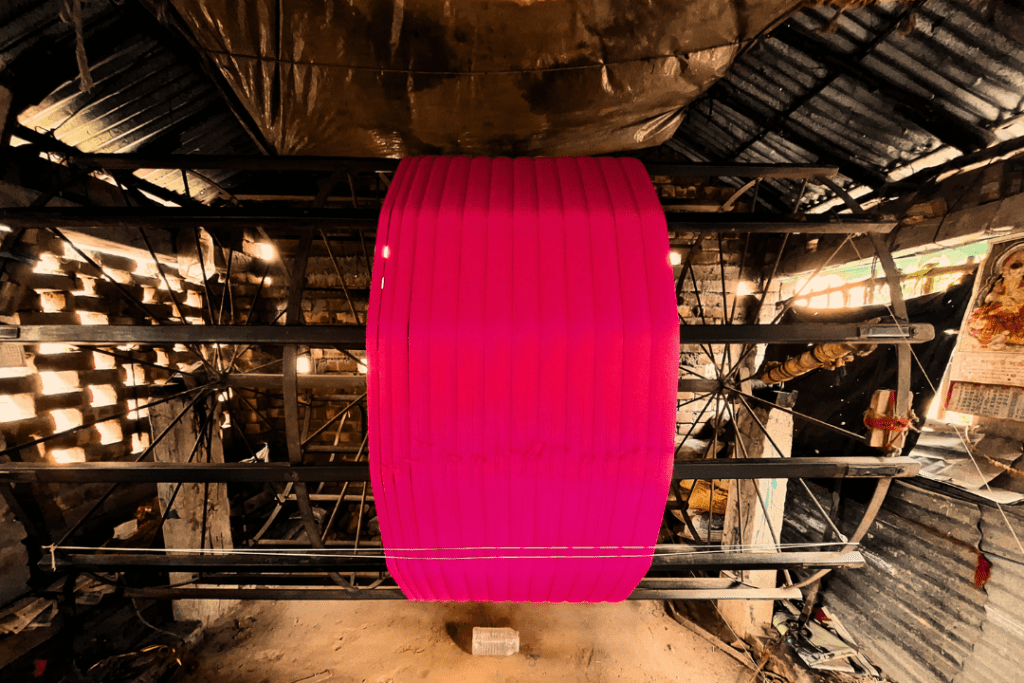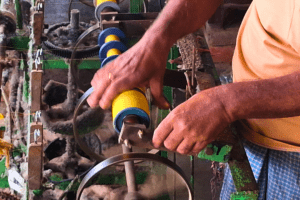Step into the enchanting world of a saree weaver in Shantipur and delve into the rich culture of this region. Shantipur, located in the Nadia district of West Bengal, is well-known for its exquisite sarees. The sarees of Shantipur are famous for their unique designs, vibrant colors, and intricate weaving patterns that have been passed down through generations. Shantipuri handloom sarees, or fabrics, are renowned for their unique designs, additional weft produced from hand spinning, arrays of colors, and delicate fabric detail. Fine Shantipuri saree is a highly sought-after item worldwide.


After India’s partition, skilled weavers from Dhaka migrated and settled in West Bengal’s Shantipur and Ambika Kalna districts. These areas have always been known for hand-woven fabrics. The government supported and encouraged these weavers, who then revived their ancestral occupation. As a result, the art of weaving flourished once again. Today, Shantipur, Fulia, Samudragarh, Dhatrigram, and Ambika Kalna produce feather-touch textiles and sarees in exotic designs and colors. Each center has its unique weaving style. Fulia and Samudragarh specialize in a combination of Jacquard and Jamdani work, based on the Tangail Saree Culture of Bangladesh. Shantipur produces superfine dhotis and Jacquards. The produce is marketed through wholesalers, cooperatives, and various undertakings.
As you explore this beautiful region, you will witness the skill and dedication that goes into creating each stunning saree. The weavers of Shantipur take great pride in their work and use only the best quality materials such as silk, cotton, and zari threads to create an exquisite piece of art. They spend countless hours weaving each saree by hand, focusing on every intricate detail, from the thickness of the thread to the pattern and design.
The Jamdani weave, a technique that is unique to Shantipur, is one of the most intricate and time-consuming methods used to create the sarees. This method involves weaving delicate patterns into the fabric by hand, which can take several months to complete. Each saree is a work of art, with its own story to tell. The designs often depict scenes from Hindu mythology, showcasing the region’s cultural heritage. Some sarees feature intricate floral and animal motifs, depicting the local flora and fauna.

The handloom tant sarees of Shantipur are quite expensive due to the high-quality materials used and the amount of time and effort invested in creating each piece. However, the unique beauty and cultural significance of these sarees make them a worthwhile investment for those who appreciate fine textiles. Purchasing a Shantipur handloom saree not only supports the local artisans but also ensures the survival of this ancient craft for generations to come.
“The handloom tant sarees are quite expensive due to the high-quality materials used and the amount of time and effort invested in creating each piece. Even though the prices may deter some buyers, the unique beauty and cultural significance of these sarees make them a worthwhile investment for those who appreciate fine textiles.”
The tant saree weavers of Shantipur work tirelessly to create intricate patterns, using a variety of weaving techniques. They use high-quality materials, including silk and cotton, to create sarees that are not only beautiful but also long-lasting.

Find out why Shantipur Tant sarees are so expensive. Explore their unique patterns and great craftsmanship, which result in stunning handwoven gems for traditional Indian dress.
The saree weaving industry is a vital part of the local economy, and the weavers take great pride in their craft. Their work is a reflection of the rich cultural heritage that has been passed down through generations. As you interact with the weavers, you will learn about their lives and the challenges they face in preserving this ancient art form.
Come and experience the magic of Shantipur for yourself, and be a part of this rich and vibrant tradition. Witness the magic of a saree being created from start to finish and take home an exquisite piece of art that you will treasure for years to come.








0 Comments